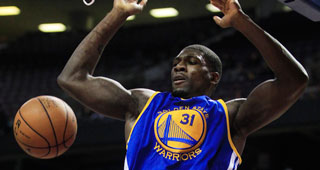Steven Adams’ impact on this year’s playoffs is no secret. After knocking off a historically good defensive team, the Thunder have gone punch for punch with perhaps the greatest team of all time, and they wouldn’t be in this position without their starting center.
While most role players struggle to utilize their skillsets when playing alongside two ball-dominant superstars, Adams benefits from it by being active on the offensive glass and rolling to the rim when so much attention is being paid to Russell Westbrook and Kevin Durant. He’s playing a role similar to what Tyson Chandler did for the Dallas Mavericks in 2011, serving as an above the rim threat and a defensive anchor.
In the playoffs, Adams is averaging nearly a double-double on 65 percent shooting. He has outplayed Andrew Bogut and held his ground when the Warriors have gone small and played Draymond Green at center. His nearly 32 minutes per game in the postseason aren’t just a sign of Oklahoma City's dependence on him, but also their trust in him. Playoff basketball is often about adjustments. The Warriors' success has largely been based on the fact that they play their preferred lineups and force opponents to adjust to them. The Thunder aren’t biting, and it might be Golden State’s turn to react.
The Warriors have their own version of Adams, and they have been reluctant to use him in the playoffs. Festus Ezeli is the type of athletic big who can, in theory, do all the things Adams can. Ezeli has only played 9.5 minutes per game in the postseason. The spark they need to regain control of the series might just be inserting him into the starting lineup.
The reality is probably that Adams is just a better player than Ezeli, but another reality is that Ezeli is almost certainly going to be paid this summer to be the type of player that Adams is right now. The Warriors are in a position to gauge whether or not he’s worth it.
Andrew Bogut’s effectiveness has been minimal in this series. Westbrook and Durant are undeterred by him and Adams has outplayed him. The beauty of Bogut on offense is that, much like their small ball lineup, the Warriors constantly have five good passers on the floor. That’s always nice, but sometimes four good passers and an above the rim finisher is better. Ezeli doesn’t need to pass if he’s always catching passes under the rim.
And then there’s Anderson Varejao. The Thunder also have a respected big man who provides locker room leadership and camaraderie. His name is Nazr Muhammad, and they don’t play him. The Warriors should take notes. Varejao provides absolutely nothing for Golden State outside of the occasional frantically successful defensive possession.
Ezeli taking on the majority of Bogut and Varejao’s minutes would open up more things for the Warriors than it would take away. Adams is a more developed player than Ezeli, but he also benefits from playing with Durant and Westbrook. Increasing the minutes that Ezeli plays alongside Steph Curry, Draymond Green, and Klay Thompson will inevitably come with an uptick in his production. A steady dose of Curry/Ezeli pick and rolls is potentially as dangerous as anything the Warriors already do.
During this series Golden State has implemented their Death Ball lineup (Green at center) earlier and more often than they have in the regular season, and it has looked a tad bit more human than it has ever seemed. This lineup is the most dangerous form of the Warriors, arguably one of the most unstoppable five-man units of all time. So the temptation is to increase its usage if the season is on the line. That logic might not work against the Thunder.
From a broad, intangible perspective, there’s a mental advantage to waiting until the fourth quarter before deploying a lineup with that kind of versatility. It’s hard enough competing with the Warriors for three quarters when they are playing some semblance of traditional basketball and still having to chase around all the shooters. Suddenly introducing position-less basketball with the game on the line can be overwhelming, Mistakes are bound to be made, and the Warriors are too precise not to take advantage of them. On the flip side, it’s only natural that you become more comfortable against any lineup the longer you play against it so giving second quarter doses of your secret weapon against a team you’re going to have to play at least three more times might not be the best idea. In the Thunder’s 133-105 blowout on Sunday, the Death Ball lineup was a -22 in point differential. Ezeli played just 10 minutes.
From a practical standpoint, one of the reasons the Warriors played the Death Ball lineup so sparingly during the season is presumably because of how taxing it could potentially be on Green over time. They are probably less worried about that in the postseason, but asking Green to match up with Adams so often might have a negative consequence. Playing Green at center is supposed to be a showcase of his skills. Against Adams it’s become an overly aggressive challenge resulting in reckless play and behavior as proven by Green kicking Adams in the groin during game four.
The Warriors need to at least make Adams reckon with someone the same size as him. He might outplay Ezeli at the end of the day, but it will take his full efforts and attention. The Thunder are the best rebounding team in the NBA. Playing small against them might provide a death blow, but it’s not sustainable.
Ezeli is big enough to get a huge contract this summer. Is he big enough for the Warriors to trust him?



